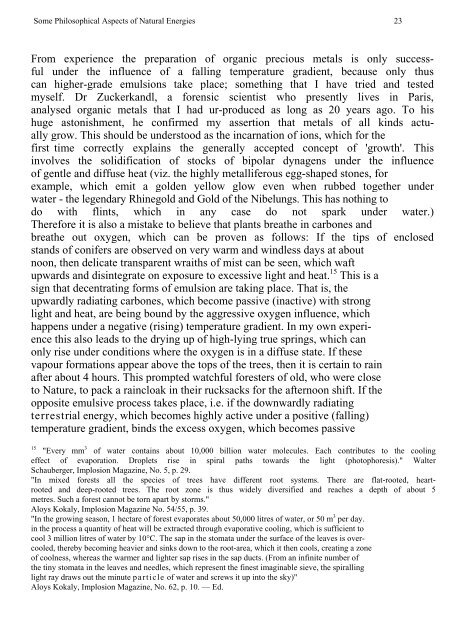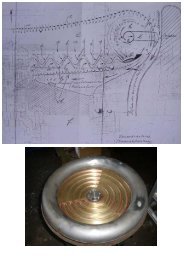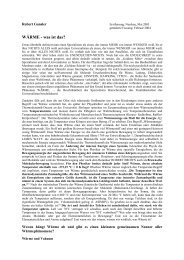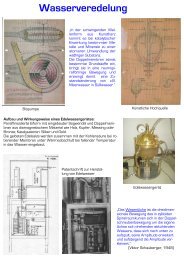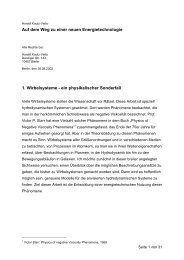Coats & Schauberger - The Energy Evolution - Harnessing Free Energy from Nature (2000)
Create successful ePaper yourself
Turn your PDF publications into a flip-book with our unique Google optimized e-Paper software.
Some Philosophical Aspects of Natural Energies 23<br />
From experience the preparation of organic precious metals is only successful<br />
under the influence of a falling temperature gradient, because only thus<br />
can higher-grade emulsions take place; something that I have tried and tested<br />
myself. Dr Zuckerkandl, a forensic scientist who presently lives in Paris,<br />
analysed organic metals that I had ur-produced as long as 20 years ago. To his<br />
huge astonishment, he confirmed my assertion that metals of all kinds actually<br />
grow. This should be understood as the incarnation of ions, which for the<br />
first time correctly explains the generally accepted concept of 'growth'. This<br />
involves the solidification of stocks of bipolar dynagens under the influence<br />
of gentle and diffuse heat (viz. the highly metalliferous egg-shaped stones, for<br />
example, which emit a golden yellow glow even when rubbed together under<br />
water - the legendary Rhinegold and Gold of the Nibelungs. This has nothing to<br />
do with flints, which in any case do not spark under water.)<br />
<strong>The</strong>refore it is also a mistake to believe that plants breathe in carbones and<br />
breathe out oxygen, which can be proven as follows: If the tips of enclosed<br />
stands of conifers are observed on very warm and windless days at about<br />
noon, then delicate transparent wraiths of mist can be seen, which waft<br />
upwards and disintegrate on exposure to excessive light and heat. 15 This is a<br />
sign that decentrating forms of emulsion are taking place. That is, the<br />
upwardly radiating carbones, which become passive (inactive) with strong<br />
light and heat, are being bound by the aggressive oxygen influence, which<br />
happens under a negative (rising) temperature gradient. In my own experience<br />
this also leads to the drying up of high-lying true springs, which can<br />
only rise under conditions where the oxygen is in a diffuse state. If these<br />
vapour formations appear above the tops of the trees, then it is certain to rain<br />
after about 4 hours. This prompted watchful foresters of old, who were close<br />
to <strong>Nature</strong>, to pack a raincloak in their rucksacks for the afternoon shift. If the<br />
opposite emulsive process takes place, i.e. if the downwardly radiating<br />
terrestrial energy, which becomes highly active under a positive (falling)<br />
temperature gradient, binds the excess oxygen, which becomes passive<br />
15<br />
"Every mm 3 of water contains about 10,000 billion water molecules. Each contributes to the cooling<br />
effect of evaporation. Droplets rise in spiral paths towards the light (photophoresis)." Walter<br />
<strong>Schauberger</strong>, Implosion Magazine, No. 5, p. 29.<br />
"In mixed forests all the species of trees have different root systems. <strong>The</strong>re are flat-rooted, heartrooted<br />
and deep-rooted trees. <strong>The</strong> root zone is thus widely diversified and reaches a depth of about 5<br />
metres. Such a forest cannot be torn apart by storms."<br />
Aloys Kokaly, Implosion Magazine No. 54/55, p. 39.<br />
"In the growing season, 1 hectare of forest evaporates about 50,000 litres of water, or 50 m 3 per day.<br />
in the process a quantity of heat will be extracted through evaporative cooling, which is sufficient to<br />
cool 3 million litres of water by 10°C. <strong>The</strong> sap in the stomata under the surface of the leaves is overcooled,<br />
thereby becoming heavier and sinks down to the root-area, which it then cools, creating a zone<br />
of coolness, whereas the warmer and lighter sap rises in the sap ducts. (From an infinite number of<br />
the tiny stomata in the leaves and needles, which represent the finest imaginable sieve, the spiralling<br />
light ray draws out the minute particle of water and screws it up into the sky)"<br />
Aloys Kokaly, Implosion Magazine, No. 62, p. 10. — Ed.


